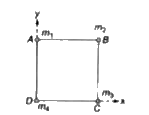Four particles of masses 1 kg, 2 kg, 3 kg and 4 kg are at the vertices of a rectangle of sides a and b with a>b. If a = 1 m, b = 2 m, what is the location of their centre of mass ? Solution in Kannada
0.5 m, 1.4 m
1.4 m, 0.5 m
0.14 m, 0.05 m
0.05 m, 0.14 m
The correct Answer is:A
Here →x=Σm1x1M
=110(0×1+2×a+3×a+4×0)=0.5m
→y=Σm1x1M
=110(0×1+2×0+3×b+4×b)
= 1.4 m

Topper's Solved these Questions
- BOOK - MODERN PUBLICATIONCHAPTER - ROTATIONAL MOTIONEXERCISE - LEVEL-III (MCQ)10videos
ROTATIONAL MOTION
- BOOK - MODERN PUBLICATIONCHAPTER - ROTATIONAL MOTIONEXERCISE - RCQ8videos
ROTATIONAL MOTION
- BOOK - MODERN PUBLICATIONCHAPTER - ROTATIONAL MOTIONEXERCISE - RCQ8videos
ROTATIONAL MOTION
- BOOK - MODERN PUBLICATIONCHAPTER - RAY OPTICSEXERCISE - RECENT COMPETITIVE QUESTION32videos
RAY OPTICS
- BOOK - MODERN PUBLICATIONCHAPTER - SOLIDS & SEMICONDUCTOR DEVICESEXERCISE - Revision Test28videos
SOLIDS & SEMICONDUCTOR DEVICES
Similar Questions
Two particles of equal mass 'm' go around a circle of radius 'R' under the action of their mutual gravitational attraction. The speed of each particle with respect to their centre of mass is :
03:49View SolutionThe moment of inertia of a circular disc of radius 2 m and mass 1 kg about an axis passing through the centre of mass but perpendicular to the plane of the disc is 2 kg m2. Its moment of inertia about an axis parallel to this axis but passing through the edge of the disc is :
 04:05View Solution
04:05View SolutionThe moment of inertia of a circular disc of radius 2 m and mass 1 kg about an axis passing through the centre of mass but perpendicular to the plane of the disc is 2 kg m2. Its moment of inertia about an axis parallel to this axis but passing through the edge of the disc is :
 03:56View Solution
03:56View SolutionA point object O is placed in front of a glass rod having spherical end of radius of curvature 30 cm. The image would be formed at
 03:46View Solution
03:46View SolutionChoose the forward biased p-n junction :
04:49View SolutionThree particles of masses 1 kg, (3)/(2) kg, and 2 kg are located the vertices of an equilateral triangle of side a . The x, y coordinates of the centre of mass are.
04:37View SolutionFour particles of mass 2 kg , 4 kg , 5 kg , and 3 kg are placed at the four vertices A, B, C and D of a square of side 1 m. Find the position of centre of mass of the particle.
05:35View SolutionFour particles of masses 1 kg, 2 kg, 3 kg, 4 kg are placed at the corners of a square of side 2 m. Find the coordinates of centre of mass.
05:35View SolutionThree particles of masses 2 kg, 4 kg and 6 kg are located at the vertices of an equilateral triangle of side 0.5 m. What is the position of centre of mass if the origin is located at 2 kg mass and 4 kg mass located along x-axis ?
View SolutionThree masses 3 kg 4 kg and 5 kg are located at the comers of an equilateral triangle of side 1 m. Locate the centre of mass of the system.
07:01View Solution1 किगा, 2 किग्रा, 3 किग्रा तथा 4 किग्रा द्रव्यमान के चार कण 1 मी भुजा के वर्ग के शीर्षों A,B,C तथा D पर रखें हैं कणों के द्रव्यमान केंद्र का स्थिति सदिश ज्ञात कीजिए।
 View Solution
View Solution1 किग्रा, 2 किग्रा, 3 किग्रा तथा 4 किग्रा द्रव्यमान के चार कण वर्ग ABCD के शीर्षों पर स्थित है AB, x- अक्ष पर है तथा AD, y- अक्ष पर है। द्रव्यमान केंद्र के निर्देशांक होंगे (वर्ग की भुजा 1 मी है)-
View SolutionFour particles of masses 1 kg, 2 kg, 3 kg and 4 kg are placed at the four vertices A, B, C and D of the square of side 1 m. Find the position of centre of mass of the particles.
05:35View SolutionThree particles of masses 1 kg, 2 kg and 3 kg are placed at the vertices A, B and C of an equilateral triangle ABC. If A and B lie at (0, 0) and (1, 0) m, the co-ordinates of their centre of mass are
05:41View SolutionThree particles of masses 1 kg, 2 kg and 3 kg are placed at the vertices A, B and C of an equiliateral triangle ABC. If A and B lie at (0, 0) and (1, 0) m, the co - ordinates of their centre of mass are
06:31View Solution

